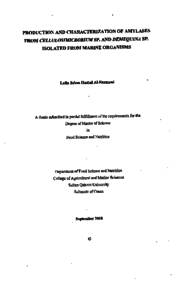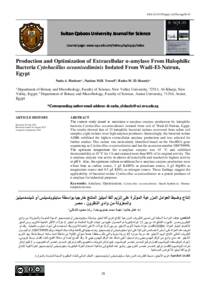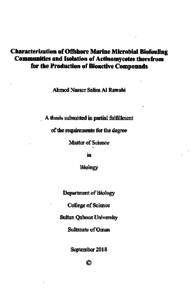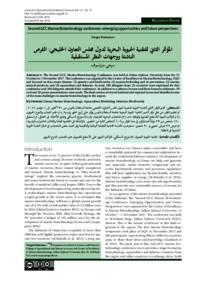Document
Production and characterization of amylases from Cellulosimicrobium sp. and Demequina sp. isolated from marine organisms
Publisher
Sultan Qaboos University
Gregorian
2010
Language
English
Subject
English abstract
Marine sources have been known to yield novel compounds with a wide range of bioactivity with various commercial applications. In this study, the abilities of bacteria isolated from eight marine organisms to produce a-amylase were examined. All eight organisms were found to harbor amylase producing bacteria. Two bacteria isolated from the green alga Ulva rigida and the sponge Mycale sp. were further identified and their aamylases were purified and characterized. The bacterial species isolated from the green alga Ulva rigida and sponge Mycale sp. were identified by DNA sequencing as Cellulosimicrobium sp. and Demequina sp., respectively Cellulosimicrobium sp. obtained maximum cell growth and amylase production at 29°C and in the presence of lactose as a carbon source. Optimal cell growth and amylase production by Demequina sp. was observed at 35°C. While lactose enhanced cell growth of Demequina sp., maximum amylase production was found when fructose and glycerol were the available sources of carbon. Both strains grew better in the presence of tryptone, whilst peptone stimulated amylase production. Maximal cell growth and amylase production by both of the strains was found at a medium salinity of 3% NaCl. Characteristics of the amylases extracted from the two strains (Amylase I from Cellulosimicrobium sp. and Amylase II from Demequina sp.) were assayed in the laboratory. Both amylases had the highest activity at 37°C and pH 7. Activity of both the enzymes was reduced in the presence of detergents, such as EDTA, SDS and totally inhibited by the denaturing agent acetone. In the presence of metal ions such as Cu2+ and Zn2+, the two amylases lost some of their activities, whereas Ca2+ and Fe2+ had stimulatory effects on both amylases. Reduction of the amylases activities by EDTA and their enhancement by Ca* indicates the calcium dependence of amylases and suggests that they are metalloenzymes. Results of this study suggest that bacteria associated with marine organisms are novel sources of a-amylases, which can be used for different commercial applications.
Member of
Resource URL
Arabic abstract
تعتبر البيئة البحرية مصدر غني للكثير من المواد الممكن استخدامها تجاريا عن طريق دراسة الكائنات البحرية و الأحياء الدقيقة التي تعيش عليها. في السنوات العشرين الماضية تم استخلاص عدد كبير من المضادات الحيوية والمواد المضادة للسرطان والمكملات الغذائية وغيرها من المستحضرات الدوائية من كائنات بحرية متعددة. في هذا البحث تم دراسة بكتيريا مستخلصة من ثمانية أنواع من الكائنات البحرية واختبار قدرتها على إفراز إنزيم الأميليز. جميع الكائنات البحرية الداخلة في الدراسة تم إثبات احتوائها على أنواع متعددة من البكتريا القادرة على إفراز إنزيم الأميليز من خلال اختبار قدرتها على تفكيك النشا وتحويله إلى مواده الأولية . نوعين من هذه البكتيريا تم عزلها ودراسة خصائصها وفصل إنزيمات الأميليز التي تفرزها لتنقيتها ودراسة خصائصها واستخداماتها. تم تصنيف البكتيريا عن طريق تحليل تسلسل الحمض النووي على أنها من نوعي سيليولوسيميكروبيوم (.Cellulosomicrobium sp) و ديميكينا (.Demequina sp).درجة حرارة 29 مئوية ووجود سكر اللاكتوز في الوسط المغذي كان المحفز الأكبر للنمو البكتيري وإفراز الأميليز من بكتيريا .Cellulosomicrobium sp في حين كان أكبر لنمو بكتيري وإفراز للأميليز من بكتريا .Demequina sp في درجة حرارة 35 مئوية مع وجود الفركتوز والجليسرول كمصدرين للكربون. من بين مصادر النيتروجين, افضل نمو لنوعي البكتريا كان في وجود التريبتون (Tryptone) في حين البيبتون (Peptone) كان المحفز الأكبر لإفراز إنزيم الأميليز. نسبة الملوحة القياسية لنمو نوعي البكتريا وإفراز انزيم الأميليز كانت في وجود 3% من كلوريد الصوديوم في الوسط المغذي وهي النسبة التي تعادل ملوحة البحر. خصائص إنزيمات الأميليز المستخلصة من نوعي البكتريا (اميليز I من بكتريا سيليولوسيميكروبيوم (.Cellulosomicrobium sp) واميليز II من بكتريا ديميكينا (.Demequina sp) تم دراستها في وجود مختلف الظروفي. أفضل الظروف النشاط نوعي إنزيمات الأميليز المستخلصة كانت في درجة حرارة 37 مئوية ودرجة حموضة 7 (7 pH). تم اختبار عدد من المواد الكيميائية وبعض المواد التي تستخدم في مواد الغسيل على النشاط الإنزيمي لنوعي الأميليز وكانت النتائج بان فقد إنزيمي الأميليز بعض من نشاطهما في وجود مواد مثل EDTA و SDS و الأسيتون. بعض الأيونات المعدنية مثل الكالسيوم (*Ca2) و الحديد (Fe24) كان لهما تأثير محفز لنشاط إنزيمي الأميليز في حين تم ملاحظة تأثير معاكس على الإنزيمين في وجود ايونات مثل الزنك (**Zn) والنحاس (*Cu2). من خلال نتائج هذا البحث يمكن الاستنتاج بان البكتريا التي تعيش على الكائنات البحرية هي مصادر غنية لانزيم الأميليز الذي يمكن استخدامة تجاريا.
Category
Theses and Dissertations






